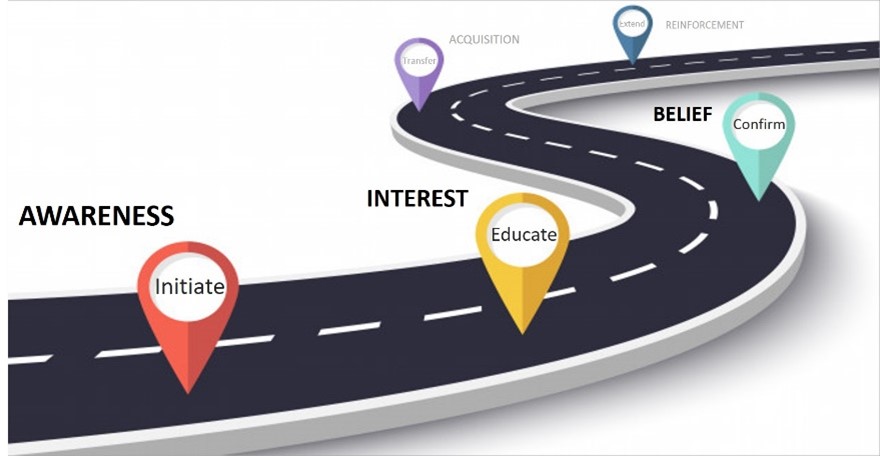
The concept of the buyer’s journey seems to have lost some of its appeal. Some B2B pundits now contend that the journey is a convoluted route with many twists, turns and dead-ends instead of a neat, linear process. How can sellers nurture sales if they’re not sure where buyers are in their process?
Given the complex nature of B2B decisions, these diverging viewpoints don’t negate the fact that buyers go through three phases of their journey before they’re ready to make a purchase decision. Keep in mind these phases may not be followed exactly in order, and buyers are likely to repeat them and change direction as needs and knowledge change.
Many buyers also don’t want you to know they’re in the market until they’re closer to making a decision. You could say sellers are in the dark until the buyer is ready to engage. This makes it difficult to support buyers in a way that’s comfortable to them. The good news is that by providing value at every point in the journey, you can identify buyers and nurture them along the way.
Is Your Buyer Ready to Buy?
The buyer’s journey is more than just a cycle, process, or tasks on a checklist. We must consider the human factor that introduces doubt and bias into the journey. The first three phases (Awareness, Interest, and Belief) must be satisfied before buyers feel ready to move forward.

Help buyers start their journey by educating, informing, and answering their questions. This is not the time to rush into sales mode or try to close the deal. Your goal is to provide tools, information, and support to encourage confidence and further engagement.
The tools you provide will vary based on where the buyer is in their journey. How you deliver those tools will also vary based on whether they want personal assistance or prefer evaluating on their own.
In the end, buyers will only be ready to engage with your sales team if they are aware of their problem, interested in solving it, and confident you can solve it for them. All three phases must be addressed.
Gaining Awareness
Awareness is a buyer’s first glimpse that they might have a problem and that there may be better ways to do what they’re doing. Your primary goal at this phase is to initiate engagement.
It’s unlikely they will want to engage with a salesperson, so offering self-service tools and information will have the greatest impact in establishing a connection. Consider using email campaigns, social media promotion, and different types of evaluation or assessment tools, such as a benchmark assessment.
These tools add value to the buyer’s journey by helping them evaluate how their organization compares to others. The goal is to get them interested enough to sign up for more educational information... information that moves them to the point of actually considering solving the problem.
The goal at this point is not to capture a lead or have a salesperson call. It’s for the buyer to gain awareness and understanding of their problem, and take their first steps toward finding a solution.
Creating Interest
How does a prospective buyer express interest in your offering? They sign up to receive some of your content: blog, newsletter, whitepaper, webinars, etc. Once they do, it’s time to begin educating them.
Education should focus on how their problem impacts their business, less so on your product or solution. Now is the time to use a supportive and educational approach to getting sales engagement. It’s not the time for a hard sell, but to ask if they have questions and provide any resources they need.
Even after you achieve sales engagement, it’s best to focus on educating and supporting, not selling. Selling begins when the buyer wants to confirm that you can actually help them. You’ll know for sure when they engage with a value calculator to estimate how much you can save them or download business value case studies that show how much other customers have saved.
Assuring Belief
To deliver value during the third phase of the buyer’s journey, you must demonstrate two things: that you can actually deliver a solution that solves the customer’s problem AND that doing so will deliver a tangible economic return.
Quite simply, the sale will not be approved if you cannot provide metrics that satisfy financial approvers within the buyer’s organization. This often requires a cost-justified business case that includes financial metrics such as ROI, NPV, and/or payback period. It isn’t enough to believe in the solution... you need to convince the organization that it’s a good business decision.
Conclusion
No matter how simple or complex the purchase decision, buyers need to be aware of their problem, interested in solving it, and believe your solution will solve it for them. Buyers want to be helped and educated during the first three phases of the journey, and don’t want to be sold to before they’re ready. The best way to get them ready is to provide value at every phase.
-------------------------------------------------------------------------------------------------------------------------------
Resources
Connect with Darrin Fleming on LinkedIn.
Join the Value Selling for B2B Marketing and Sales Leaders LinkedIn Group.
Visit the ROI Selling Resource Center.









